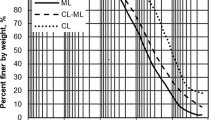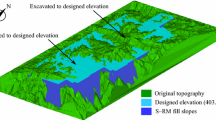Abstract
Granite binary structure slopes and residual soil slopes containing spheroidal boulders formed by differential weathering are widely distributed along the southeast coast of China. Field studies demonstrate that the failure of differentially weathered granite slopes mainly occurs at soil–rock interfaces. Only few studies have been conducted on the shear characteristics of the interfaces between rocks and granite residual soil. Moreover, mechanics models describing the engineering properties of the interfaces have not been developed. In this study, the ring shear tests are conducted on a granite residual soil–rock interface using the orthogonal design method and considering factors such as the roughness of granite, water content and initial dry density, shear rate, and number of drying–wetting cycles. A mechanics model that can precisely demonstrate the shear characteristics of the interface is also developed, and its validity is verified using test results. The findings indicate that the roughness of granite and the water content of the residual soil are the main factors affecting the interface shear stress. As the increase of granite roughness, the peak internal friction angle, residual internal friction angles, and peak cohesion of soil–rock interface increase. The residual cohesion of the interface, however, decreases as the roughness of granite increases. As the water content of the soil increases, both the interface shear stress and internal friction angle initially start to increase and then decrease. With the increase of the number of drying–wetting cycles, the internal friction angle and peak cohesion of the interface decrease.




















Similar content being viewed by others
Data availability
All data, models, or codes that support the findings of this study are available from the corresponding author upon reasonable request.
Abbreviations
- R a :
-
Roughness
- m 1 :
-
The granite sample mass on the lower surface
- m 1 :
-
The granite sample mass on the upper surface
- r 1 and r 2 :
-
The outer and inner diameters of the granite samples
- h :
-
The height of the granite samples
- S :
-
The surface area of the upper part of the granite samples
- \(\overline{S_{p1}}, \overline{S_{p2}}, \overline{S_{p3}}, \overline{S_{p4}}\) :
-
The peak shear stress of the interface under each factor
- \(\overline{S_{r1}}, \overline{S_{r2}}, \overline{S_{r3}}, \overline{S_{r4}}\) :
-
The corresponding average value of the residual shear stress
- R p :
-
The range value of the peak shear stress
- R r :
-
The average difference of the residual shear stress
- w :
-
Water content
- ρ :
-
Initial dry density
- v :
-
Shear rate
- φ p :
-
Peak internal friction angle
- c p :
-
Peak cohesive strength
- φ r :
-
Residual internal friction angle
- c r :
-
Residual cohesion
- τ :
-
Shear stress
- u :
-
Shear displacement
- E t :
-
Tangent modulus
- E i :
-
Initial tangent modulus
- τ ult :
-
Ultimate shear force
- R f :
-
Damage ratio
- p a :
-
Atmospheric pressure
- τ f :
-
Shear stress under a particular displacement
- σ n :
-
Normal stress
- K, n, a, and b :
-
Test parameters
- \(k_p,\ k_r, k_s\) :
-
Shear modulus
References
An R, Kong L, Li C, Luo X (2020) Strength attenuation and microstructure damage of granite residual soils under hot and rainy weather. Chin J Rock Mech Eng 39:1902–1911. https://doi.org/10.13722/j.cnki.jrme.2020.0073
Chen XB, Zhang JS, Xiao YJ, Li J (2015) Effect of roughness on shear behavior of red clay—concrete interface in large-scale direct shear tests. Can Geotech J 52:1122–1135. https://doi.org/10.1139/cgj-2014-0399https://doi.org/10.1139/cgj-2014-0399
Cui Z, YAang J, Chen Y (2007) The type and evolution of the granite landforms in China. Acta Geogr Sin 62:675–690. https://doi.org/10.3321/j.issn:0375-5444.2007.07.001
Day RA, Potts DM (1994) Zero thickness interface elements—numerical stability and application. Int J Numer Anal Methods Geomech 18:689–708. https://doi.org/10.1002/nag.1610181003
Desai CS, Ma YZ (1992) Modeling of joints and interfaces using the disturbed-state concept. Int J Numer Anal Methods Geomech 16:623–653. https://doi.org/10.1002/nag.1610160903
Frost JD, DeJong JT, Recalde M (2002) Shear failure behavior of granular-continuum interfaces. Eng Fract Mech 69:2029–2048. https://doi.org/10.1016/S0013-7944(02)00075-9
Ghionna VN, Mortara G (2002) An elastoplastic model for sand-structure interface behaviour. Geotechnique 52:41–50. https://doi.org/10.1680/geot.52.1.41.40826
Guo CC, Lin PY, Guo PF, Wang FM, Zhao LG (2021) A Weibull-based damage model for the shear softening behaviours of soil-structure interfaces. Geotech Res 8:54–63. https://doi.org/10.1680/jgere.20.00043
Gw C, Jm D (1971) Finite element analyses of retaining wall behavior. J Soil Mech Found Div 97:1657–1673. https://doi.org/10.1061/JSFEAQ.0001870
Janbu N (1963) Soil compressibility as determined by odometer and triaxial tests. Proc Europ Conf SMFE 1:19–25. https://doi.org/10.12691/ajcea-5-4-1
Jian W, Hu H, Luo Y, Tang W (2017) Experimental study on deterioration of granitic residual soil strength in wetting-drying cycles. J Eng Geol 25:592–597. https://doi.org/10.13544/j.cnki.jeg.2017.03.003
Jian W, Huang C, Luo Y, Nie W (2020) Experimental study on wetting front migration induced by rainfall infiltration in unsaturated eluvial and residual soil. Rock Soil Mech 41:1123–1133. https://doi.org/10.16285/j.rsm.2019.0491
Kondner RL (1963) Hyperbolic stress-strain response: cohesive soils. J Soil Mech Found Div 89:115–143. https://doi.org/10.1061/JSFEAQ.0000479
Lashkari A (2012) A critical state model for saturated and unsaturated interfaces. Sci Iran 19:1147–1156. https://doi.org/10.1016/j.scient.2012.06.025
Liao SP (2003) Types of deformation damage and its stability analysis for soil-like road graben slopes. Chin J Rock Mech Eng S2:2765–2772. https://doi.org/10.3321/j.issn:1000-6915.2003.z2.049
Liu P, Chen RP, Wu K, Kang X (2020a) Effects of drying-wetting cycles on the mechanical behavior of reconstituted granite-residual soils. J Mater Civ Eng 32. https://doi.org/10.1061/(ASCE)MT.1943-5533.0003272
Liu WP, Ouyang GQ, Luo XY, Luo J, Hu L, Fu MF (2020b) Moisture content, pore-water pressure and wetting front in granite residual soil during collapsing erosion with varying slope angle. Geomorphology (Amst) 362. https://doi.org/10.1016/j.geomorph.2020.107210
Liu WP, Song XQ, Huang FM, Hu LN (2019) Experimental study on the disintegration of granite residual soil under the combined influence of wetting-drying cycles and acid rain. Geomat Nat Hazards Risk 10:1912–1927. https://doi.org/10.1080/19475705.2019.1651407
Liu X, Zhang X, Yue H, Kong L, Xu C (2020c) SHPB tests on dynamic impact behavior of granite residual soil. Rock Soil Mech 41:2001–2008. https://doi.org/10.16285/j.rsm.2019.0822
Maghsoodi S, Cuisinier O, Masrouri F (2021) Non-isothermal soil-structure interface model basedon critical state theory. Acta Geotech 16:2049–2069. https://doi.org/10.1007/s11440-020-01133-1
Pham K, Kim D, Lee IM, Choi H (2019) Hydraulic-mechanical properties of unsaturated granite-weathered residual soil in Korea. Vadose Zone J 18. https://doi.org/10.2136/vzj2018.10.0188
Saberi M, Annan C, Konrad J, Lashkari A (2016) A critical state two-surface plasticity model for gravelly soil-structure interfaces under monotonic and cyclic loading. Comput Geotech 80:71–82. https://doi.org/10.1016/j.compgeo.2016.06.011
Scaringi G, Hu W, Xu Q, Huang RQ (2018) Shear-rate-dependent behavior of clayey bimaterial interfaces at landslide stress levels. Geophys Res Lett 45:766–777. https://doi.org/10.1002/2017GL076214
Su L, Hu B, Xie Q, Yu F, Zhang C (2020) Experimental and theoretical study of mechanical properties of root-soil interface for slope protection. J Mt Sci 17:2784–2795. https://doi.org/10.1007/s11629-020-6077-4
Wang D, Zeng Q, Wang J, Zhou M (2020) Effect of dry-wet cycle on stability of granite residual soil slope. IOP Conf Ser: Earth Environ Sci 526:12046. https://doi.org/10.1088/1755-1315/526/1/012046
Wang H, Liu C, Chen Z (2011) Granite spherical weathering features and related engineering geological problems in the southeast area of Fujian province. J Eng Geol 19:564–569. https://doi.org/10.3969/j.issn.1004-9665.2011.04.018
Wang J, Chen X, Zhang Z, Zhang R, Zhu B, Gong Y, Liu H, Yuan S (2019) Preference flow at rock-soil interface and its influence on soil water dynamics in the karst troughs. Carsol Sin 38:109–116. https://doi.org/10.11932/karst20190112
Zhou JJ, Yu JL, Gong XN, El Naggar MH, Zhang RH (2020) The effect of cemented soil strength on the frictional capacity of precast concrete pile-cemented soil interface. Acta Geotech 15:3271–3282. https://doi.org/10.1007/s11440-020-00915-x
Zhu B, Wen K, Li T, Wang L, Kong D (2019) Experimental study on lateral pile–soil interaction of offshore tetrapod piled jacket foundations in sand. Can Geotech J 56:1680–1689. https://doi.org/10.1139/cgj-2018-0292
Funding
This study received financial support from the National Natural Science Foundation of China (No. 42007235, No. U2005205, No. 41972268) and the Science and Technology Innovation Platform Project of Fuzhou Science and Technology Bureau (No. 2021-P-032).
Author information
Authors and Affiliations
Corresponding author
Rights and permissions
Springer Nature or its licensor (e.g. a society or other partner) holds exclusive rights to this article under a publishing agreement with the author(s) or other rightsholder(s); author self-archiving of the accepted manuscript version of this article is solely governed by the terms of such publishing agreement and applicable law.
About this article
Cite this article
Dou, Hq., Xie, Sh., Chen, F. et al. Study on shear characteristics and a mechanics model of granite residual soil–rock interface. Bull Eng Geol Environ 82, 212 (2023). https://doi.org/10.1007/s10064-023-03220-5
Received:
Accepted:
Published:
DOI: https://doi.org/10.1007/s10064-023-03220-5




